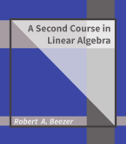Section 1.3 Orthogonal Complements
¶Theorem (((above on repeated sums))) mentions repeated sums, which are of interest. However, when we begin with a vector space \(V\) and a single subspace \(W\text{,}\) we can ask about the existence of another subspace, \(W\text{,}\) such that \(V=U\ds W\text{.}\) The answer is that such a \(W\) always exists, and we then refer to it as a complement of \(U\text{.}\)
Definition 1.3.1. Subspace Complement.
Suppose that \(V\) is a vector space with a subspace \(U\text{.}\) If \(W\) is a subspace such that \(V=U\ds W\text{,}\) then \(W\) is the complement of \(V\text{.}\)
Every subspace has a complement, and generally it is not unique.
Lemma 1.3.2. Every Subspace has a Complement.
Suppose that \(V\) is a vector space with a subspace \(U\text{.}\) Then there exists a subspace \(W\) such that \(V=U\ds W\text{,}\) so \(W\) is the complement of \(V\text{.}\)
Proof.
Suppose that \(\dimension{V}=n\) and \(\dimension{U}=k\text{,}\) and let \(B=\set{\vectorlist{u}{k}}\) be a basis of \(U\text{.}\) With \(n-k\) applications of Theorem ELIS we obtain vectors \(\vectorlist{v}{n-k}\) that succesively create bases \(B_i=\set{\vectorlist{u}{k},\,\vectorlist{v}{i}}\text{,}\) \(0\leq i\leq n-k\) for subspaces \(U=U_0, U_1,\dots,U_{n-k}=V\text{,}\) where \(\dimension{U_i}=k+i\text{.}\)
Define \(W=\spn{\set{\vectorlist{v}{n-k}}}\text{.}\) Since \(\set{\vectorlist{u}{k},\,\vectorlist{v}{i}}\) is a basis for \(V\) and \(\set{\vectorlist{u}{k}}\) is a basis for \(U\text{,}\) we can apply Theorem (((Direct Sum From a Basis (above)))) to see that \(V=U\ds W\text{,}\) so \(W\) is the complement of \(V\text{.}\) (Compare with (((Direct Sum From One Subspace (above)))), which has identical content, but a different write-up.)
The freedom given when we “extend” a linearly independent set (or basis) to create a basis for the complement means that we can create a complement in many ways, so it is not unique.
Checkpoint 1.3.3.
Consider the subspace \(U\) of \(V=\complex{3}\text{,}\)
Create two different complements of \(U\text{,}\) being sure to prove that your complements are unequal (and not simply have unequal bases). Before reading ahead, can you think of an ideal (or “canonical”) choice for the complement?
Checkpoint 1.3.4.
Consider the subspace \(U\) of \(V=\complex{5}\text{,}\)
Create a complement of \(U\text{.}\) (If you have read ahead, do not create an orthogonal complement for this exercise.)
With an inner product, and a notion of orthogonality, we can define a canonical, and useful, complement for every subspace.
Definition 1.3.5. Orthogonal Complement.
Suppose that \(V\) is a vector space with a subspace \(U\text{.}\) Then the orthogonal complement of \(U\) (relative to \(V\)) is
A matrix formulation of the orthogonal complement will help us establish that the moniker “complement” is deserved.
Theorem 1.3.6. Orthogonal Complement as a Null Space.
Suppose that \(V\) is a vector space with a subspace \(U\text{.}\) Let \(A\) be a matrix whose columns are a spanning set for \(U\text{.}\) Then \(\per{U}=\nsp{\adjoint{A}}\text{.}\)
Proof.
Membership in the orthogonal complement requires a vector to be orthogonal to every vector of \(U\text{.}\) However, because of the linearity of the inner product (Theorem IPVA, Theorem IPSM), it is equivalent to require that a vector be orthogonal to each member of a spanning set for \(U\text{.}\) So membership in the orthogonal complement is equivalent to being orthogonal to each column of \(A\text{.}\) We obtain the desired set equality from the equivalences,
Theorem 1.3.7. Orthogonal Complement Decomposition.
Suppose that \(V\) is a vector space with a subspace \(U\text{.}\) Then \(V=U\ds\per{U}\text{.}\)
Proof.
We first establish that \(U\cap\per{U}=\set{\zerovector}\text{.}\) Suppose \(\vect{u}\in U\) and \(\vect{u}\in\per{U}\text{.}\) Then \(\innerproduct{\vect{u}}{\vect{u}}=0\) and by Theorem PIP we conclude that \(\vect{u}=\zerovector\text{.}\)
We now show that an arbitrary vector \(\vect{v}\) can be written as a sum of vectors from \(U\) and \(\per{U}\text{.}\) Without loss of generality, we can assume we have an orthonormal basis for \(U\text{,}\) for if not, we can apply the Gram-Schmidt process to any basis of \(U\) to create an orthogonal spanning set, whose individual vectors can be scaled to have norm one (Theorem GSP). Denote this basis as \(B=\set{\vectorlist{u}{k}}\text{.}\)
Define the vector \(\vect{v}_1\) as a linear combination of the vectors of \(B\text{,}\) so \(\vect{v}_1\in U\text{.}\)
Define \(\vect{v}_2 = \vect{v}-\vect{v}_1\text{,}\) so trivially by construction, \(\vect{v}=\vect{v}_1+\vect{v}_2\text{.}\) It remains to show that \(\vect{v}_2\in\per{U}\text{.}\) We repeatedly use properties of the inner product. This construction and proof may remind you of the Gram-Schmidt process. For \(1\leq j\leq k\text{,}\)
We have fulfilled the hypotheses of Theorem Theorem 1.2.5 and so can say \(V=U\ds\per{U}\text{.}\)
Theorem Theorem 1.3.7 gives us a canonical choice of a complementary subspace, which has useful orthogonality properties. It also allows us to decompose any vector (uniquely) into an element of a subspace, plus an orthogonal vector. This might remind you in some ways of “resolving a vector into compoments” if you have studied physics some.
Given a matrix, we get a natural vector space decomposition.
Corollary 1.3.8. Matrix Subspace Decomposition.
Suppose that \(A\) is an \(m\times n\) matrix. Then
Proof.
Theorem Theorem 1.3.7 provides the first equality and Theorem Theorem 1.3.6 gives the second.
Checkpoint 1.3.9.
Compute the orthogonal complement of the subspace \(U\subset\complex{3}\text{.}\)
Form the matrix \(A\text{,}\) whose columns are the two basis vectors given for \(U\) and compute the null space \(\nsp{\adjoint{A}}\) by row-reducing the matrix. (Theorem Theorem 1.3.6)
So
Checkpoint 1.3.10.
Compute the orthogonal complements of the two subspaces from Exercises Checkpoint 1.3.3 and Checkpoint 1.3.4. For the subspace of \(\complex{5}\) verify that your first complement was not the orthogonal complement (or return to the exercise and find a complement that is not orthogonal).
